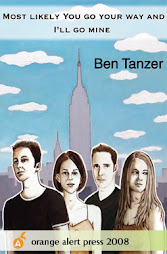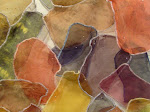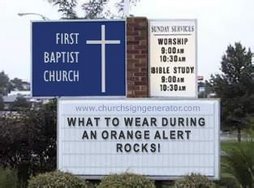 Ellen Priest
Ellen PriestBy nature paint has a certain movement to it, but some artists allow the paint to move more then others. Some choose to apply the paint in a specific way while others may move the canvas in a certain way. However, artist Ellen Priest has a very different approaches to the concept of movement. Hers is a technique that mixes jazz music and the layering of music inspired brush studies. That's right Jazz music, and if you are looking for movement then Jazz is really where you should turn. Ellen prefers to work more with jazz suites like with her current pieces based on "Venezuelan Suite" by Edward Simon, but I imagine this would work with any type of Jazz and any type of music for that matter. Ellen has been working exclusively with Jazz since 1990, an
The process of creating a particular piece actually begins with a series of other pieces, or brush studies. When you visit Ellen's site you can actually see how these pieces are put together like a puzzle and then retraced to make the finished work. The deep and texture needs to be studied in person, but hopefully we can give you a taste right here.
Recently, Ellen took some time away from submitting her application for a Guggenheim Fellowship to answer a few of my questions.
 Orange Alert (OA): How would you describe your work?
Orange Alert (OA): How would you describe your work?Ellen Priest (EP): My paintings are abstract, made of superimposed layers of paper. My visual language shows the influence of Abstract Expressionism, among other sources. You can see it in the marks I use, and the way I apply paint. At their best my paintings embody a translucent, multi-layered space, sometimes open, sometimes dense, depending on the specific musical subject matter, full of color and light. The standard building blocks for physically making my layered, collaged pictures are papers of varying opacities, saturated colors painted with oil or flashe, and pencil-drawn lines. The translucent papers and oil paint allow one to see, quite literally, a painting through a painting.
OA: What is it specifically about Jazz that you find so inspiring?
EP: Jazz is a musical counterpart to the visual experience I try to set up in my work. It evokes in me what I want to express in my paintings, functioning much like a mountain panorama for a landscape painter. The jazz that attracts me is full of joy and energy, able to transform sadness.

OA: Is there a particular type of Jazz or period of Jazz that you prefer to work with?
EP: I listen to all sorts of jazz and Latin music, also African. I enjoy both the classics like Miles Davis and John Coltrane, and contemporary jazz. I gravitate toward piano and saxophone. The piano carries melody, harmony and percussion all together, and the sax has a certain “bite” and many rich voices. I also seem to select composer/performers playing their own music Edward Simon, Geri Allen, Branford Marsalis, Danilo Perez, Chris Potter, Herbie Hancock, Wayne
Shorter, and Chick Corea are some of my favorites. I love African and Latin American music because it deepens my sense of rhythm, keeps me fresh, especially when musicians come from those traditions into jazz -- Lionel Loueke for example.
OA: Your process of layering seems unique to me. How did you first come to work this way?
EP: This may be a LOT longer than you want, but it’s my best answer to this frequent question written several years ago:
My desire to try layering a picture grew from two sources. The first was artistic. In the late 1970s, I read Harold Rosenberg’s monograph about Willem de Kooning, who made ink drawings on trace and moved them around on top of each other to find new shapes for his paintings. I was intrigued, made some still-life drawings, and found that I liked the stacked drawings on their own merit layered pictures with shapes of varying clarity.
The second source was experiential. One November, after a horrible period in my personal life, I was driving a familiar turnpike in Connecticut and realized the trees were brown. I had missed the entire fall – all the gorgeous colors and crispness – preoccupied by unhappy events.
An insight flashed. I had seen so many gorgeous falls along that stretch of road that I could substitute a “photograph” from my memory – a transparent overlay of saturated fall colors on a bright blue day superimposed over the brown. Limitless other overlays then came to mind: political events I’d heard on the news as I drove, summer colors, windy days with those rich edgy feelings they carry, temperatures and smells, religious and emotional experiences, memories of friends I’d ridden with, papers I’d composed while driving in grad school.
I realized something else. We constantly have that experience of a clear, simple visual subject – a mountain, a dog, my fall panorama, a lunchbox – giving way to the rich layers of our memory, our symbolic thinking, our physical sensations, etc., then just as magically dissolving, taking us back to the clear, simple visual subject in front of us. Thus, layering occurs naturally in our minds.
An insight flashed. I had seen so many gorgeous falls along that stretch of road that I could substitute a “photograph” from my memory – a transparent overlay of saturated fall colors on a bright blue day superimposed over the brown. Limitless other overlays then came to mind: political events I’d heard on the news as I drove, summer colors, windy days with those rich edgy feelings they carry, temperatures and smells, religious and emotional experiences, memories of friends I’d ridden with, papers I’d composed while driving in grad school.
I realized something else. We constantly have that experience of a clear, simple visual subject – a mountain, a dog, my fall panorama, a lunchbox – giving way to the rich layers of our memory, our symbolic thinking, our physical sensations, etc., then just as magically dissolving, taking us back to the clear, simple visual subject in front of us. Thus, layering occurs naturally in our minds.

OA: Do you have a set color pallet that you work with or does it all depend on the piece of music?
EP: Color is a direct, intuitive response to a specific jazz composition. The palette in each series is somewhat different, though I do have certain “habits,” like using black and white as colors. I
keep my colors clear, not grayed down.
OA: Giving the the various elements of your work do you feel that the on-line gallery or portfolio really serves its purpose? How do you feel the internet has impacted your work and visibility in general?
EP: I don’t think the internet has impacted my artwork itself. However, my new website http://www.ellenpriest.com/has brought viewers to my paintings that I would not have had, like yourself. We launched it only last February, so I’ll wait to comment on its long-term impact. The little Quicktime movie, opened by clicking the painting on my homepage, is critical. Still photos alone don’t get across the physical surface and depth of the work.
The internet has impacted my ability to see what else is going on the visual arts quickly and far more broadly than I could before -- very helpful.
OA: What's next for Ellen Priest?
EP: When the “Venezuelan Suite” paintings are finished later this year (based on Edward Simon’s 4- movement “Venezuelan Suite”), I’ll take a break doing some lithographs and drawings. My next big project will work with the music of pianist/composer Geri Allen. I expect to begin on one of her pieces in the spring. I love the physical, percussive quality of her playing.
For more information on Ellen Priest please visit her website.
+by+Nick+Volkert).jpg)

















No comments:
Post a Comment